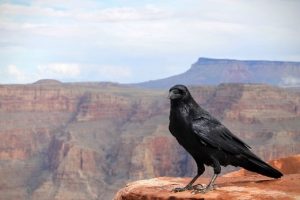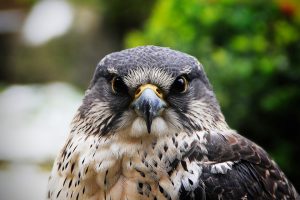Blog
Differences Between Similar Animals
Do you ever wonder whether a big black bird is a crow or a raven? Or whether a croaking frog is really a toad? What about that swooping bird – is it a falcon or a hawk? There are some animals that seem really difficult to tell apart! Here are some easy ways to know the difference.
River Otter or Sea Otter
Did you know that river otters and sea otters are both members of the carnivorous weasel family? Sea otters are more than twice as big, eat and sleep floating on their backs, and eat marine animals like sea urchins, crabs, clams and octopuses. River otters eat fish, frogs, crayfish, bugs, rats and birds, and they sleep on land in underground dens.
Enjoy watching sea otters from a distance in Monterey or come to CuriOdyssey to see river otters up close! https://curiodyssey.org/animals/our-animals/mammals/river-otter/
Is it a Raven or Crow?
Common ravens and American crows look so similar! But ravens are as big as hawks and travel in pairs. Crows are more like the size of pigeons and they travel in groups. A raven’s calls sound like a deep-sounding croak, but a crow makes the familiar “caw-caw” sound. But don’t be fooled, both ravens and crows are known for mimicking other animals and each other! Ravens have a longer neck and larger bill with finger-like feathers at the end of their wings and a wedge-shaped tail in flight while a crow’s tail fans out in flight.
Learn more from the National Audubon Society, then follow the link to BirdNote to hear the differences in their sounds: https://www.audubon.org/news/how-tell-raven-crow
Dangerous or Not? Kingsnake vs. Coral Snake
Nonvenomous kingsnakes are one of the most common snakes in North America but they look a lot the highly venomous nocturnal and reclusive coral snake. Both have skins marked with vibrant rings of color that camouflage them by breaking up their appearance to predators. Both can be found hiding in forests of the eastern United States or under rocks in desert terrain. Coral snakes eat lizards while kingsnakes constrict rodents, birds and lizards. Kingsnakes in North America usually have red heads and their red bands touch their black bands, but coral snakes in the U.S. usually have black heads and their red bands are always bordered by yellow bands on either side.
Here’s are two rhymes to remember the difference: “red touches black, friend of Jack. Red touches yellow, dangerous fellow” or the variant, “red touches black, you’re okay Jack. Red touches yellow, you’re a dead fellow”.
Visit CuriOdyssey’s kingsnakes and learn more about each snake family at livescience.com or: https://snakebuddies.net/2010/09/03/red-and-yellow-kills-a-fellow-your-identification-guide-to-tri-color-snakes/
Is it a Lynx or a Bobcat
Is it a lynx or a bobcat? Sometimes it can be both! Bobcats and other species known as lynx are all in the genus Lynx. Bobcats are North America’s most common native cat and are smaller than the Canadian, Eurasian or Spanish lynx. Bobcats have delicate paws without fur on their soles and shorter ear tufts than lynx so they look more like a house cat. Lynx prefer rabbits over other prey. Bobcats have mottled color fur and eat not only rabbits but also birds and mice. Bobcats are more aggressive than other lynx and will even hunt a dear many times its own size.
Learn more about the different lynx species from our friends at the San Diego Zoo and then come visit CuriOdyssey’s beautiful bobcat: https://animals.sandiegozoo.org/animals/lynx-and-bobcat
Turtles and Tortoises
Both the turtle and tortoise are egg-laying reptiles with a protective shell because they are too slow to outrun predators. Both animals are ectothermic, relying on their environment for warmth. Turtles live in or near water, swim with webbed feet, are omnivorous (except the algae-eating green sea turtle) and their food varies depending upon their environment. Tortoises live on land, eat only vegetation and have stubby feet with sharp claws for digging. Visit CuriOdyssey’s desert tortoise, red-eared sliders or Western pond turtles and learn more at livescience.com or: https://www.britannica.com/demystified/whats-the-difference-between-a-turtle-and-a-tortoise
Is it a Monarch or Viceroy Butterfly?
The viceroy butterfly looks remarkably similar to the monarch butterfly, with bright orange wings with black edges and lines. But viceroys are smaller, have a black line running along the edge of its hindwings, they don’t migrate and their flight is more erratic than the monarch. The monarch ingests toxic cardiac glycosides from milkweed plants, making it an unappetizing snack to birds, snakes and toads. Viceroy’s coloring is protective mimicry, protecting them from birds, frogs and snakes that learned orange and black butterflies are not tasty morsels.
Learn about their protective mimicry and the toxic compounds used by these butterflies at: https://blogs.britannica.com/2011/05/mutual-mimicry-viceroy-monarch/
Was That a Frog or Toad?
Frogs and toads help us by controlling the world’s insect population. Frogs live in water and have smooth skin and teeth, while toads have bumpy skin and no teeth. You can see the difference in skin texture between CuriOdyssey’s red-legged frog and Western toad. Some frogs have toxic skin secretions but toads have glands behind their eyes that secrete a burning toxin. Frogs and toads eat insects, spiders, worms, slugs and small fish. Frog spit is one of the stickiest saliva on the planet!
See frogs’ fascinating tongue and spit in action at: https://www.npr.org/sections/thetwo-way/2017/01/31/512622260/to-catch-prey-frogs-turn-to-sticky-spit
Hawk vs. Falcon
Hawks and falcons can be difficult to tell apart. Hawks are as large as small eagles, have sharped talons and can fly for a long time. Both hunt small birds but hawks also eat rats, mice, gophers and rabbits. Hawks nest on rocky cliffs or trees and hunt by suddenly darting from behind a concealed perch, killing prey with their angular beak. Falcons nest in manmade structures and dive and catch prey so suddenly that the speed of the catch can kill the prey instantly.
Visit CuriOdyssey’s Swainson’s hawk and peregrine falcon and learn how to identify raptors in flight at: https://www.audubon.org/news/identify-raptors-flight
If You Want More
If you enjoyed learning more about wildlife, check out Wildlife in Winter, More Wildlife in Winter, and Simple Ways You Can Help Wildlife.
Then come see CuriOdyssey’s rescued native wildlife up close!
Join the CuriOdyssey Community
LOCATION
1651 Coyote Point Drive
San Mateo, CA 94401
Ohlone Land Acknowledgement
650-342-7755
[email protected]
CuriOdyssey is a 501(c)(3) non-profit, Tax ID 94-1262434












